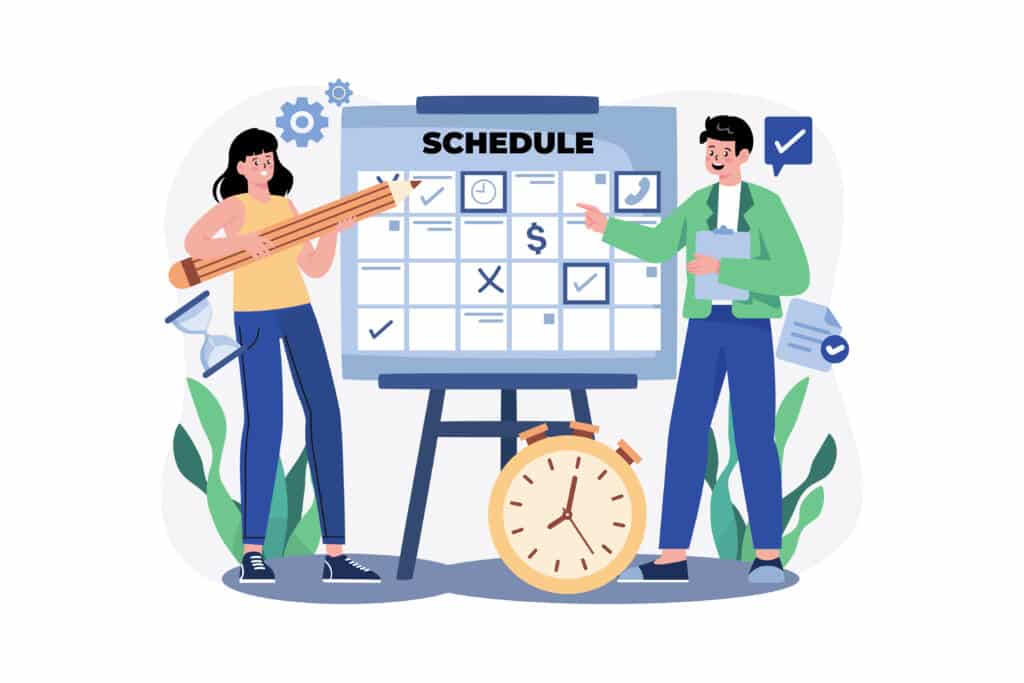
In today’s fast-paced and demanding work environment, effective calendar management is essential for professionals striving to optimize their productivity and achieve success.
This article presents 10 practical and innovative tips to better schedule your time at work.
From scheduling beyond just meetings to establishing calendar etiquette guidelines and utilizing time management techniques, this guide offers strategies to streamline workflow and enhance time management skills.
By implementing these tips, professionals can improve their efficiency, organization, and ultimately, their overall work performance.
Key Takeaways
- Time-blocking strategies for work-life balance
- Respecting time blocks for focused work
- Saying no to commitments to focus on what matters
- Utilizing appointment slots for efficient scheduling
1. Schedule More Than Just Meetings
Time blocking strategies can help achieve this balance by allocating specific time slots for various tasks and activities.
By scheduling more than just meetings, individuals can prioritize their workload, allocate time for focused work, personal development, self-care, and breaks. This approach ensures that all aspects of work and life are given due importance and attention.
Incorporating work-life balance into calendar management not only improves productivity and efficiency but also promotes overall well-being and satisfaction.
Learn more about strategies to do calendar management for your business- Read Here
2. Work Calendar Etiquette Guidelines
Establishing work calendar etiquette guidelines is essential for effective time management and coordination within a professional setting. By setting clear boundaries and expectations for how calendars are used, individuals and teams can optimize their schedules and improve overall productivity.
| Guideline | Description | Benefits |
| Respect time blocks | Avoid scheduling meetings or tasks during designated time blocks | Allows for focused work and minimizes interruptions |
| Communicate availability | Share your calendar with team members and update it regularly | Enhances collaboration and coordination among colleagues |
| Prioritize important tasks | Use effective time blocking techniques to prioritize important tasks and allocate dedicated time for them | Increases productivity and ensures important work gets done |
3. Resist the FOMO
How can you resist the FOMO and just say no when it comes to managing your calendar at work? Prioritization techniques and maintaining a healthy work-life balance are key.
It’s crucial to understand that saying no to certain commitments allows you to focus on what truly matters and maintain your productivity. Start by setting clear priorities and aligning your schedule accordingly. Evaluate each request or invitation based on its importance and alignment with your goals.
Remember that your time is valuable and should be spent on activities that contribute to your success. Embrace the power of delegation and learn to trust others with tasks that are not essential to your role.
Hire a proficient Virtual Assistant to manage and evaluate calendar management & scheduling at an affordable price- Explore Here
4. Use Appointment Slots
To enhance your calendar management skills and optimize your work schedule, consider utilizing appointment slots as a valuable tool. Here are four ways appointment slots can streamline scheduling and maximize efficiency:
1. Eliminate back-and-forth emails
By setting up appointment slots in your calendar, you can share a link with colleagues or clients, allowing them to easily book a time that works for both parties. This eliminates the need for lengthy email exchanges to find a suitable meeting time.
2. Avoid double bookings
Appointment slots ensure that only one person can book a specific time slot, preventing the risk of overlapping meetings or commitments.
3. Set specific availability
With appointment slots, you can define specific time frames when you are available for meetings or appointments. This helps you maintain a structured and organized schedule.
4. Receive notifications and reminders
Appointment slots can be set up to send automated notifications and reminders to both you and the person booking the appointment. This helps to keep everyone on track and ensures that meetings are not forgotten or missed.
5. Share Your Calendar With Team Members
By incorporating the practice of sharing your calendar with team members, you can enhance collaboration and improve coordination within your work environment. Collaborative scheduling allows team members to view each other’s calendars, ensuring that everyone is aware of each other’s availability and commitments. This not only facilitates efficient planning of meetings and projects but also avoids scheduling conflicts.
By sharing your calendar, you promote transparency and open communication within your team, fostering a culture of teamwork and accountability. It also enables team members to align their schedules and allocate resources effectively, resulting in improved productivity and a streamlined workflow.
Additionally, sharing your calendar encourages a sense of trust and reliability among team members, as they can rely on the accuracy and up-to-date information provided.
What is CRM, its basics and its importance for any business model today- Read Here
6. Regularly Review and Optimize Your Calendar
To ensure effective time management, it is essential to regularly review and optimize your calendar. By reviewing the effectiveness of your calendar and making necessary adjustments, you can optimize your productivity and make the most of your time at work.
Here are four ways to do so:
1. Analyze your schedule
Take a close look at your calendar and evaluate how you are allocating your time. Identify any patterns or areas where you may be spending too much or too little time.
2. Prioritize tasks
Determine which tasks are the most important and allocate sufficient time for them. Consider using techniques such as time blocking or task batching to streamline your workflow.
3. Eliminate unnecessary meetings
Review the meetings on your calendar and assess their value and impact. Remove any meetings that are not essential or could be replaced with more efficient alternatives.
4. Seek feedback and make adjustments
Regularly seek input from colleagues or mentors to gain insight into your calendar management strategies. Use this feedback to make adjustments and improve your scheduling practices.
Develop your own software for Calendar Management, scheduling & project management- Hire a developer now!
7. Feel the Rhythm
To optimize your calendar management and enhance your productivity at work, it is important to develop a keen sense of the rhythm in which you work.
Understanding your personal rhythm allows you to schedule tasks effectively and maximize your energy levels throughout the day. Each person has their own natural rhythms, such as being more alert in the morning or experiencing an afternoon slump. By identifying these patterns, you can align your schedule with your peak productivity times and allocate tasks accordingly.
Incorporating breaks and breathing space into your calendar also helps maintain a steady flow of work without feeling overwhelmed or burnt out. By being mindful of your personal rhythm and natural rhythms, you can create a work schedule that optimizes your performance and promotes innovation.
Types of financial planning that one should know- Read Here
8. Set Realistic Deadlines
Setting realistic deadlines is crucial for effective calendar management and optimal productivity in the workplace. By setting expectations and prioritizing tasks, you can ensure that you allocate enough time for each activity and avoid overloading your schedule.
Here are four strategies to help you set realistic deadlines:
1. . Assess the complexity of the task
Consider the level of difficulty and the amount of time required to complete each task. Break down complex projects into smaller, more manageable tasks to accurately estimate the time needed.
2. Consult stakeholders
Engage with team members and clients to understand their expectations and deadlines. Collaborate to set mutually agreed-upon deadlines that align with everyone’s needs.
3. Consider potential obstacles
Anticipate any potential roadblocks or challenges that may arise during the task’s completion. Account for these obstacles when setting deadlines to avoid unnecessary delays.
4. Allow buffer time
Leave room for unexpected delays or additional revisions. Building in buffer time ensures that you have flexibility in your schedule and can accommodate any unforeseen circumstances.
9. Track Your Time
By implementing a time tracking system, professionals can gain valuable insights into their work habits and effectively manage their schedules. Time tracking tools provide a way to monitor how time is being spent, allowing individuals to identify areas of improvement and make necessary adjustments.
Conducting a time audit is a recommended practice to track time accurately. This involves recording and categorizing activities throughout the day, providing a comprehensive overview of how time is allocated. Time tracking tools can automate this process, making it easier for professionals to monitor their productivity levels and identify any inefficiencies.
Additionally, these tools can generate reports and analytics that offer valuable insights into work patterns and time utilization. By tracking time, professionals can optimize their schedules, prioritize tasks, and allocate time more effectively, ultimately increasing productivity and achieving better work-life balance.
10. Accept Imperfection
Embrace the concept of imperfection to cultivate a more realistic and flexible approach to managing your time effectively. Accepting limitations and embracing flexibility can help you navigate the unpredictable nature of work and personal responsibilities.
Here are four reasons why accepting imperfection is crucial for effective time management:
1. Prioritization
Recognize that you can’t do it all and focus on what truly matters. By accepting that you have limitations, you can prioritize tasks based on their importance and impact.
2. Adaptability
Embracing flexibility allows you to adjust your schedule when unexpected events or opportunities arise. Being rigid can lead to missed opportunities or unnecessary stress.
3. Learning and Growth
Acknowledging imperfection opens the door to learning from mistakes and discovering new approaches. It encourages innovation and fosters personal and professional growth.
4. Work-Life Balance
Embracing imperfection helps you find a balance between work and personal life. It allows you to be present in the moment and enjoy both aspects without feeling guilty or overwhelmed.
Final words
In conclusion, mastering time management in a dynamic work environment is pivotal for professional success. These ten strategies offer a comprehensive approach to calendar management, enabling individuals to go beyond mere meeting scheduling. By embracing work-life balance, establishing etiquette guidelines, and harnessing the power of appointment slots, professionals can streamline their workflow, enhance productivity, and elevate their overall performance.
Adopting these tips not only optimizes time allocation but also fosters a healthier, more efficient work routine, empowering individuals to achieve their goals while maintaining a sustainable work-life equilibrium.
Frequently Asked Questions (FAQ)
How Can Color-Coding Your Calendar Help With Organization and Productivity?
Color-coding your calendar can help with organization and productivity by providing a visual representation of different tasks and priorities. It allows for easy identification of time blocks and helps in prioritizing tasks effectively, resulting in improved time management and overall productivity.
What Is Day Theming and How Can It Help With Time Management?
Day theming is a time management technique that involves assigning specific themes or focus areas to different days of the week. It helps prioritize tasks, improve work-life balance, and increase productivity by providing structure and clarity in scheduling.
What Are Some Effective Strategies to Minimize Distractions and Improve Focus?
To create a productive work environment, it is important to employ strategies that minimize distractions and improve focus. Techniques such as eliminating interruptions, setting boundaries, and practicing mindfulness can help individuals stay on task and achieve optimal productivity.
How Can Identifying Your Personal Rhythm Help in Scheduling Tasks Effectively?
Identifying your personal rhythm can help in scheduling tasks effectively by allowing you to align your energy levels with specific activities. Time blocking strategies can then be used to allocate focused periods of productivity during peak energy times.
What Are Some Tips for Improving Company Meeting Culture and Effectiveness?
Improving communication and enhancing collaboration in company meetings can be achieved by implementing effective meeting checklists, promoting open and inclusive discussions, setting clear objectives, and ensuring active participation from all attendees.








